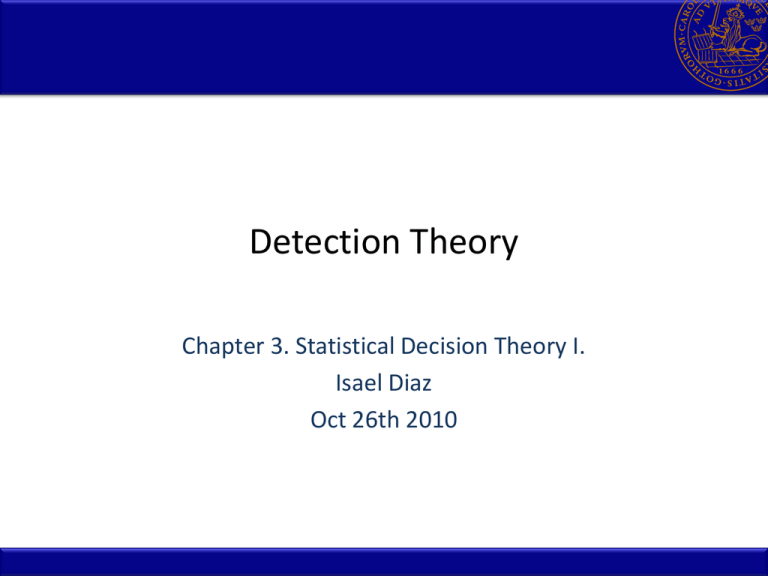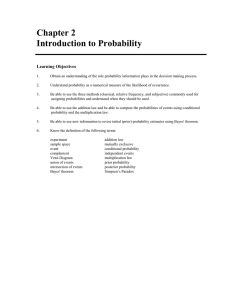Statistical Decision Theory I
advertisement

Detection Theory
Chapter 3. Statistical Decision Theory I.
Isael Diaz
Oct 26th 2010
Outline
•
•
•
•
•
•
Neyman-Pearson Theorem
Detector Performance
Irrelevant Data
Minimum Probability of Error
Bayes Risk
Multiple Hypothesis Testing
Chapter Goal
• State basic statistical groundwork for detectors design
• Address simple hypothesis , where PDFs are known (Chapter 6
will cover the case of unknown PDFs)
• Introduction to the classical approach based on Neyman-Pearson
and Bayes Risk
– Bayesian methods employ prior knowledge of the hypotheses
– Neyman-Pearson has no prior knowledge
Bayes vs Newman-Pearson
• The particular method employed depends upon our willingness
to incorporate prior knowledge about the probabilities of
ocurrence of the various hypotheses
• Typical cases
– Bayes : Communication systems, Pattern recognition
– NP : Sonar, Radar
Nomenclature
( ,
H
2
) : G a u s s ia n P D F w ith m e a n a n d v a ria n c e
i
p(x | H i)
2
: H y p o th e s is i
: P r o b a b i li t y o f o b s e r v i n g x u n d e r a s s u m p r i o n H
P ( H i ; H j ) : P r o b a b i li t y o f d e t e c t i n g H i , w h e n i t i s H
i
j
P ( H i | H j ) : P r o b a b i li t y o f d e t e c t i n g H i , w h e n H j w a s o b s e r v e d
L(x)
: L i k e li h o o d o f x
Nomenclature cont...
• Note that
true.
P(H i; H j )
is the probability of deciding Hi, if Hj is
• While P ( H i | H j ) assumes that the outcome of a probabilistic
experiment is observed to be Hj and that the probability of
deciding Hi is conditioned to that outcome.
Neyman-Pearson Theorem
Neyman-Pearson Theorem cont...
H
0
: x[0 ] w[0 ]
H 1 : x[ 0 ] s[ 0 ] w [ 0 ]
• It is no possible to reduce
both error probabilities
simultaneously
• In Neyman-Pearson the approach is to hold one error probability
while minimizing the other.
Neyman-Pearson Theorem cont...
• We wish to maximize the
probability of detection
PD P ( H 1 ; H 1 )
• And constraint the
probability of false alarm
PF A P ( H 1 ; H 0 )
• By choosing the threshold γ
Neyman-Pearson Theorem cont...
• To maximize the probability of detection for a given probability of
false alarm decide for H1 if
L(x)
p ( x; H 1)
p ( x; H 0 )
Likelihood ratio test
• with
PF A
{ x:L ( x ) }
p ( x; H 0 )dx
Likelihood Ratio
• The LR test rejects the null hypothesis if the value of this statistic
is too small.
• Intuition: large Pfa -> small gamma -> not much larger p(x,H1)
than p(x;H0)
• Limiting case: Pfa->1
• Limiting case: Pfa->0
L(x)
p ( x; H 1 )
p ( x; H 0 )
Neyman-Pearson Theorem cont...
• Example 1
• Maximize
PD P ( H 1 ; H 1 )
• Calculate the threshold so that
PF A 1 0
3
Neyman-Pearson Theorem Example 1
γ'
(1)
exp( )
(6)
(2)
(7)
(3)
(8)
(4)
(5)
γ' 3
Question
How can Pd be improved?
Answer is: Only if we allow for a larger Pfa.
NP gives the optimal detector!
By allowing a Pfa of 0.5, the Pd is increased to 0.85
System Model
• In the General case
• Where the signal s[n]=A for A>0 and w[n] is WGN with variance
σ².
• It can be shown that the sum of x is a sufficient statistic
• The summation of x[n] is sufficient.
Detector Performance
• In a more general definition
Energy-to-noise-ratio
Or
where
Deflection Coefficient
Detector Performance cont...
• An alternative way to present
the detection performance
γ ' in c re a s in g
γ'
Receiver Operating Characteristic (ROC)
Irrelevant data
• Some data not belonging to the desired signal might actually be
useful.
• The observed data-set is { x [ 0 ], x [1], ..., x [ N 1], w [ 0 ], w [1], ..., w [ N 1]
• If
R
x[ n ] w[ n ]
H
0
:
w R w[n ]
R
R
x[ n ] A w [ n ]
H1 :
w R w[n ]
• Then the reference noise can be used to improve the detection.
The perfect detector would become
T x[0 ] w R [0 ]
A
2
Irrelevant data cont...
• Generalizing, using the NP theorem
• If they are un-correlated
• Then, x2 is irrelevant and
L ( x1 , x 2 ) L ( x1 )
Minimum Probability Error
• The probability of error is defined with Bayesian paradigm as
• Minimizing the probability of error, we decide H1 if
• If both prior probabilities are equal we have
Minimum Probability Error example
• An On-off key communication system , where we transmit either
S 0 [ n ] 0 o r S1[ n ] A
• The probability of transmitting 0 or A is the same ½. Then, in
order to minimize the probability of error γ=1
Minimum Probability Error example ...
A n a lo g o u s to N P , w e d e c id e H 1 if x A
2
Deflection Coefficient
Then we calculate the Pe
The probability error decreases monoto
nically with respect of the deflection
coefficient
Bayes Risk
• Bayes Risk assigns costs to the type of errors, C i j denotes the
cost if we decide H i but H j is true. If no error is made, no
cost is assigned.
• The detector that minimizes Bayes risk is the following
Multiple Hyphoteses testing
• If we have a communication system, M-ary PAM (pulse amplitud
modulation) with M=3.
Multiple Hyphoteses testing cont...
• The conditional PDF describing the communication system is
given by
• In order to maximize p(x|Hi), we can minimize
Multiple Hyphoteses testing cont...
• Then
• Therefore
Multiple Hyphoteses testing cont...
• There are six types of Pe, so Instead of calculating Pe, we calculate
Pc=1-Pe, the probability of correct desicion
• And finally
Multiple Hyphoteses testing cont...
Binary Case
Pe Q
PAM Case
NA
4
2
2
Pe
Q
3
4
NA
4
2
2
In the digital communications world, there is a difference in the
energy per symbol, which is not considered in this example.
Chapter Problems
• Warm up problems: 3.1, 3.2
• Problems to be solved in class: 3.4, 3.8, 3.15, 3.18, 3.21







